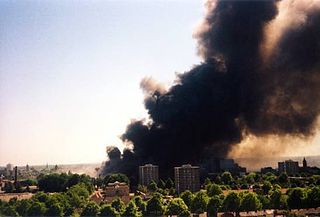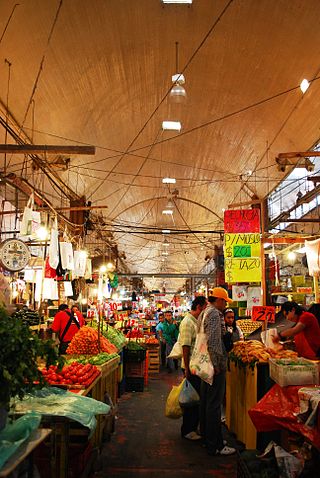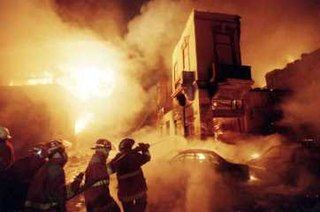Related Research Articles

The Enschede fireworks disaster was a catastrophic fireworks explosion on 13 May 2000 in Enschede, Netherlands. The explosion killed 23 people including four firefighters and injured 950 others. A total of 400 homes were destroyed and 1,500 buildings were subsequently damaged.
There have been many extremely large explosions, accidental and intentional, caused by modern high explosives, boiling liquid expanding vapour explosions (BLEVEs), older explosives such as gunpowder, volatile petroleum-based fuels such as gasoline, and other chemical reactions. This list contains the largest known examples, sorted by date. An unambiguous ranking in order of severity is not possible; a 1994 study by historian Jay White of 130 large explosions suggested that they need to be ranked by an overall effect of power, quantity, radius, loss of life and property destruction, but concluded that such rankings are difficult to assess.

On the morning of December 31, 2007, ten fireworks stores began burning in Barangay Turo, Bocaue, Bulacan, Philippines, causing a series of explosions in the area. The fire lasted for almost an hour and caused several traffic jams on Fortunato F. Halili Avenue and the North Luzon Expressway.

The La Merced Market is a traditional public market located in the eastern edge of the historic center of Mexico City and is the largest retail traditional food market in the entire city. The area, also called La Merced, has been synonymous with commercial activity since the early colonial period when traders arrived here from other parts of New Spain. At one time, nearly the entire neighborhood was filled with market stalls and in the 1860s it was decided to build a permanent market on the grounds of the old La Merced monastery. In the first half of the 20th century, this market was the major wholesaler for the entire city. This ended when the Central de Abasto was opened in the 1980s, but La Merced remains the largest traditional retail market. The market area is also known for flagrant prostitution in which women can be seen soliciting at all hours of the day and night. It is estimated that about one third of these prostitutes are underage.
The 2010 Puebla oil pipeline explosion was a large oil pipeline explosion that occurred at 5:50 am CST on December 19, 2010, in the city of San Martín Texmelucan de Labastida, Puebla, Mexico. The pipeline, running from Tabasco to Hidalgo, was owned by the Pemex petroleum company, and exploded after thieves from the Los Zetas drug cartel attempted to siphon off the oil. The gas explosion and resulting oil fire killed 29 people, including thirteen children, and injured 52. Some of the flames in the fire became ten metres high, and the smoke towered over the city. Firefighters eventually controlled the blaze, but electricity and water remained cut following the explosions, and the military was deployed to the site. Mexican President Felipe Calderón visited the explosion site on the day of the incident to offer condolences to the victims' families. The fire was one of the deadliest in Mexican history, largely destroying an area of five-kilometre radius, and some oil may have polluted the Atoyac River.

Mexican handcrafted fireworks production is mostly concentrated in the State of Mexico in central Mexico. The self-declared fireworks capital of Mexico is Tultepec, just north of Mexico City. Although the main ingredient for fireworks, gunpowder, was brought by the conquistadors in the 16th century, fireworks became popular in Mexico in the 19th century. Today, it is Latin America’s second largest producer, almost entirely for domestic use, with products ranging from small firecrackers to large shells and frames for pyrotechnics called “castillos” (castles) and “toritos”. The industry is artisanal, with production concentrated in family-owned workshops and small factories with a number operating illegally. The relatively informal production and sales of fireworks have made it dangerous with a number of notable accidents in from the late 1990s to the present, despite attempts to safety regulations.
The 2012 Sivakasi factory explosion was an explosion at the Om Sakthi Fireworks Industries fireworks factory in Sivakasi, India, on 5 September 2012. 40 people were killed and more than 70 injured. The tragedy occurred in a fireworks factory which did not have a valid licence.

The Mesa Redonda fire occurred on Saturday, 29 December 2001 in Lima, Peru. The disaster killed at least 291 people and injured at least another 134. It is one of the worst firework-related fire in history in terms of deaths.

On 10 April 2016 at approximately 03:30 AM IST, the Puttingal Temple in Paravur, Kollam, Kerala, India, experienced a fireworks accident after firework celebrations went awry. As a result, 111 people were killed and more than 350 were injured, including some with severe burns. The temple and at least 150 houses in the area of the temple were damaged by the blast. According to local reports and eyewitnesses, the explosion and fire were caused by sparks from a firecracker being used in a competitive fireworks display igniting fireworks in a concrete storehouse. About 15,000 pilgrims were visiting the temple to mark local Hindu celebrations during the last day of a seven-day festival of the goddess Bhadrakali.

On 10 December 2016, a freight train derailed, exploded and caught fire in the village of Hitrino in Shumen Province, Bulgaria, killing at least seven people and injuring 29 others.

On 20 December 2016, a fireworks accident occurred at the San Pablito Market in the city of Tultepec, north of Valley of Mexico. At least 42 people were killed in the explosion, and dozens injured.
On September 26, 1999, a stockpile of illegally stored fireworks and gunpowder exploded in the Mexican city of Celaya, killing 63 people and wounding 348 others.
On 18 January 2019, a pipeline transporting gasoline exploded in the town of Tlahuelilpan, in the Mexican state of Hidalgo. The blast killed at least 137 people and injured dozens more. Mexican authorities blamed fuel thieves, who had illegally tapped the pipeline. The explosion was particularly deadly because large crowds of people had gathered at the scene to steal fuel. Security forces tried to persuade people to move away from the scene, but they were outnumbered and asked not to engage with civilians for fear of causing a violent confrontation. The leak was reported at 17:04 CST (23:04 UTC), and the explosion occurred two hours later at 19:10. It took about four hours for responders to extinguish the fire.
References
- 1 2 3 4 5 "Mexico City Bans Fireworks; Blaze Toll at 62". The Los Angeles Times. December 13, 1988. Retrieved December 22, 2016.
- 1 2 "At Least 52 Killed in Mexico City In Fireworks Explosion and Blaze". The New York Times. December 12, 1988. Retrieved December 22, 2016.
- ↑ Caño, Antonio (December 13, 1988). "Tragedia en México al incendiarse un alamacén de cohetes". El País (in Spanish). Retrieved August 11, 2018.
- 1 2 3 "Fireworks Blast in Mexico City Kills 51". The Los Angeles Times. December 12, 1988. Retrieved December 22, 2016.